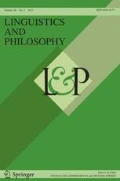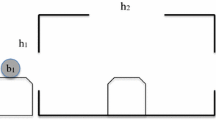Abstract
This paper investigates the interpretation of counterfactual conditionals. The main goal of the paper is to provide an account of the semantic role of similarity in the evaluation of counterfactuals. The paper proposes an analysis according to which counterfactuals are treated as predications “de re” over past situations in the actual world. The relevant situations enter semantic composition via the interpretation of tense. Counterfactuals are treated as law-like conditionals with de re predication over particular facts. Similarity with respect to particular facts is ensured by the semantics of tense in interaction with the modal, while the modal itself is responsible for invoking laws. In the paper, various arguments are provided to support a local view of similarity over the global approach found in semantics along the line of Lewis’s and Stalnaker’s. Arguments are also provided tying the evaluation of similarity to the interpretation of tense. Finally, arguments are provided to show that in key cases, the approaches make comparable predictions.
Similar content being viewed by others
References
Abusch D. (1997) Sequence of tense and temporal de re. Linguistics and Philosophy 20: 1–50
Arregui, A. (2004). On the accessibility of possible worlds: The role of tense and aspect. Dissertation, University of Massachusetts, Amherst.
Arregui A. (2007a) When aspect matters: The case of would-conditionals. Natural Language Semantics 15: 221–264
Arregui, A. (2007b). Resolving similarity in embedded contexts. In O. Bonami & P. Cabredo Hofherr (Eds.), Empirical issues in syntax and semantics 7. https://doi.org/www.cssp.cnrs.fr/eiss7/index_en.html.
Arregui, A. (2008). On the role of past tense in resolving similarity, In A. Grønn (Ed.), Proceedings of SuB12 (pp. 17–31). Oslo: ILOS. ISBN 978-82-92800-00-3.
Bennett J. (2003) A philosophical guide to conditionals. Clarendon, Oxford
Bhatt, R., & Pancheva, R. (2006). Conditionals. In The Blackwell companion to syntax (Vol. II, pp. 638– 687). Oxford: Blackwell.
Condoravdi C. (2001) Temporal interpretation of modals. In: Beaver D., Kaufman S., Clark B., Casas L. (eds) Stanford papers in semantic. CSLI Publications, Palo Alto
Dekker, P.J.E., Zeijlstra, H.H. (eds) (2006) Concord phenomena and the syntax-semantics interface. Malaga, ESSLLI
Dudman V.H. (1984) Conditional interpretations of if-sentences. Australian Journal of Linguistics 4: 143–204
Enç M. (1987) Anchoring conditions for tense. Linguistic Inquiry 18: 633–657
Enç M. (1996) Tense and modality. In: Lappin S. (eds) The handbook of contemporary semantic theory. Blackwell, London, pp 345–358
Fine K. (1975) Review of Lewis 1973. Mind 84: 451–458
Han C.-H. (2006) Variation in form-meaning mapping between Korean and English counterfactuals. Journal of East Asian Linguistics 15(2): 167–193
Hazen A. (1979) Counterpart theoretic semantics for modal logic. The Journal of Philosophy 76: 319–338
Heim I. (1990) E-type pronouns and donkey anaphora. Linguistics and Philosophy 13: 137–177
Heim I. (1994). Comments on Abusch’s theory of tense. In: Kamp H. (eds). Ellipsis, tense and questions. Amsterdam, University of Amsterdam, pp. 141–170
Heim, I. (2005). Features on bound pronouns, ms. MIT.
Heim I., Kratzer A. (1998) Semnatics in generative grammar. Blackwell, Oxford
Iatridou, S. (1991). Topics in conditionals. Dissertation, MIT.
Iatridou S. (2000) The grammatical ingredients of counterfactuality. Linguistic Inquiry 31: 231–270
Ippolito M. (2003) Presuppositions and implicatures in counterfactuals. Natural Language Semantics 11: 145–186
Ippolito, M. (2004). Imperfect modality. In J. Guéron & J. Lecarme (Eds.), The syntax of time (pp. 359–387). Cambridge: MIT Press.
Kamp H. (1979) Events, instants, and temporal reference. In: Bäuerle R., Egli U., von Stechow A. (eds) Semantics from different points of view. Springer-Verlag, Berlin, pp 376–417
Kratzer A. (1977) What must and can must and can mean. Linguistics and Philosophy 1: 337–355
Kratzer A. (1981) The notional category of modality. In: Eikmeyer H.-J., Rieser H. (eds) Words, worlds and contexts. De Gruyter, Berlin, pp 38–74
Kratzer A. (1989) An investigations of the lumps of thought. Linguistics and Philosophy 12: 607–653
Kratzer A. (1998) More structural analogies between pronouns and tenses. In: Strolovitch D., Lawson A. (eds) Proceedings of salt VIII. CLC Publications, Ithaca
Kratzer A. (2002) Facts: Particulars of information units?. Linguistics and Philosophy 25: 655–670
Kratzer, A. (2006a). Situations in natural language semantics. Stanford Encyclopedia of Philosophy.
Kratzer, A. (2006b). Minimal pronouns, ms. Umass.
Kusumoto, K. (1998). Tense in embedded contexts. Dissertation, University of Massachusetts, Amherst.
Kusumoto K. (2005) On the quantification over times in natural language. Natural Language Semantics 13: 317–357
Landman F. (1991) Structures for semantics. Kluwer Academic Publishers, Dordrecht
Legate J.-A. (2003) The morphosyntax of Warlpiri counterfactual conditionals. Linguistic Inquiry 34(1): 155–162
Lewis D. (1973) Counterfactuals. Harvard University Press, Cambridge
Lewis, D. (1979). Counterfactual dependence and time’s arrow. Noûs, 13, 455–476. (Reprinted in Lewis, D. (1986). Philosophical Papers (Vol. 2). Oxford: Oxford University Press.)
Lewis D. (1983) Individuation by acquaintance and by stipulation. Philosophical Review 92: 3–32
Ogihara T. (1996) Tense, attitudes, and scope. Kluwer Academic Publishers, Dordrecht
Ogihara, T. (2000). Counterfactuals, temporal adverbs, and association with focus. In Proceedings of SALT 10 (pp. 115–131). Ithaca: CLS Publications.
Ogihara, T. (2004). The semantics of ta in Japanese counterfactual conditionals, ms.
Ogihara, T. (2006). Counterfactual conditionals and focus cross-linguistically, ms.
Palmer F.R. (1986) Mood and modality. Cambridge University Press, Cambridge
Palmer F.R. (2001) Mood and modality (2nd ed). Cambridge University Press, Cambridge
Partee B. (1973) Some structural analogies between tense and pronouns. The Journal of Philosophy 70: 601–609
Pollock J. (1976) Subjunctive reasoning. D. Reidel, Dordrecht
Rothstein S. (1995) Adverbial quantification over events. Natural Language Semantics 3: 1–31
Rullmann H. (2004) First and second person pronouns as bound variables. Linguistic Inquiry 35: 159–168
Sauerland U. (2002) The present tense is vacuous. Snippets 6: 12–13
Schlenker P. (2003) A plea for monsters. Linguistics and Philosophy 26: 29–120
Stalnakers R. (1968) A theory of conditionals. In: Rescher N. (eds) Studies in Logical Theory 2. Blackwell, Oxford, pp 98–122
Stowell T. (1996) The phrase structure of tense. In: Rooryck J., Zaring L. (eds) Phrase structure and the lexicon. Kluwer, Dordrecht, pp 277–291
Veltman F. (2005) Making counterfactual assumptions. Journal of Semantics 22: 159–180
von Fintel, K. (1994). Restrictions on quantifier domains. Dissertation, University of Massachusetts, Amherst.
von Fintel K. (2001) Counterfactuals in a dynamic context. In: Kenstowicz M. (eds) Ken Hale: A Life in Language. MIT Press, Cambridge, pp 132–152
von Fintel, K., & Heim, I. (2005). Intensional semantics lecture notes, ms. MIT.
von Stechow, A. (2003). Feature deletion under semantic binding: Tense, person and mood under verbal quantifiers. In M. Kadowaki & S. Kawahara (Eds.), Proceedings of NELS 33 (pp. 379–403). Amherst: GLSA
Zagona K. et al (1995) Temporal argument structure: Configurational elements of construal. In: Bertinetto P.M. (eds) Temporal reference, aspect and actionality, Vol.1: Semantic and syntactic perspectives. Rosenberg & Sellier, Torino
Author information
Authors and Affiliations
Corresponding author
Rights and permissions
About this article
Cite this article
Arregui, A. On similarity in counterfactuals. Linguist and Philos 32, 245–278 (2009). https://doi.org/10.1007/s10988-009-9060-7
Received:
Accepted:
Published:
Issue Date:
DOI: https://doi.org/10.1007/s10988-009-9060-7




